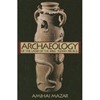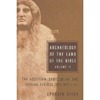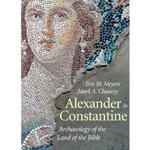If I asked my readers for the top volume on archaeology of Israel from the Old Testament period, my guess is that most would  choose Amihai Mazar’s Archaeology of the Land of the Bible: 10,000–586 BCE. Those who didn’t select it would likely at least recognize the title of this best-selling work for the last two decades. I would guess that fewer readers would be familiar with the second volume in the series. Ephraim Stern’s Archaeology of the Land of the Bible, Volume II was released in 2001 and covers the years 732 to 333 BC. Though this is also a period
choose Amihai Mazar’s Archaeology of the Land of the Bible: 10,000–586 BCE. Those who didn’t select it would likely at least recognize the title of this best-selling work for the last two decades. I would guess that fewer readers would be familiar with the second volume in the series. Ephraim Stern’s Archaeology of the Land of the Bible, Volume II was released in 2001 and covers the years 732 to 333 BC. Though this is also a period  of Old Testament history (from Hezekiah through Nehemiah), my sense is that not as many people know of or own this book. At $60, the casual reader will be turned away. The third volume in the series has just been published, but the volume’s title and cover do not clearly communicate its relationship with Mazar’s and Stern’s volumes. Alexander to Constantine: Archaeology of the Land of the Bible, by Eric M. Meyers and Mark A. Chancey, is the third in the trilogy, carrying the archaeological survey forward from the Hellenistic to the Late Roman periods. Brief chapters at the beginning and end address the Persian and Byzantine periods, but the focus is on the 1st centuries BC and AD, as can be seen by these chapter titles: 3. Herod the Great and the Introduction of Roman Architecture (33 pages)
of Old Testament history (from Hezekiah through Nehemiah), my sense is that not as many people know of or own this book. At $60, the casual reader will be turned away. The third volume in the series has just been published, but the volume’s title and cover do not clearly communicate its relationship with Mazar’s and Stern’s volumes. Alexander to Constantine: Archaeology of the Land of the Bible, by Eric M. Meyers and Mark A. Chancey, is the third in the trilogy, carrying the archaeological survey forward from the Hellenistic to the Late Roman periods. Brief chapters at the beginning and end address the Persian and Byzantine periods, but the focus is on the 1st centuries BC and AD, as can be seen by these chapter titles: 3. Herod the Great and the Introduction of Roman Architecture (33 pages) 4. Khirbet Qumran and the Dead Sea Scrolls (30 pages) 5. From Herod to the Great Revolt (26 pages) 6. The Great Revolt and the Bar Kokhba Rebellion (35 pages) 7. The Emergency of Christianity (29 pages) The book arrived a few days ago and so I haven’t yet read it, but an initial review suggests that it will be an ideal survey of the archaeological finds from these periods for several reasons:
4. Khirbet Qumran and the Dead Sea Scrolls (30 pages) 5. From Herod to the Great Revolt (26 pages) 6. The Great Revolt and the Bar Kokhba Rebellion (35 pages) 7. The Emergency of Christianity (29 pages) The book arrived a few days ago and so I haven’t yet read it, but an initial review suggests that it will be an ideal survey of the archaeological finds from these periods for several reasons:
- Eric M. Meyers is a distinguished scholar with decades of experience in field archaeology in these periods.
- At just under 300 pages (excluding endnotes and indices), this work covers the essentials but will not overwhelm the reader.
- The book is lavishly illustrated with photos, maps, and reconstructions. I would estimate that there are more than 100 illustrations.
To conclude, if you are looking for a readable and up-to-date survey of the archaeological record from about 300 BC to AD 300 written by leading scholars in the field, I would start with this one. At the moment, Amazon is listing it as a pre-order with a discount of 44% off ($40 marked down to $22.52). In my experience, prices marked down this much during pre-order increase upon release.